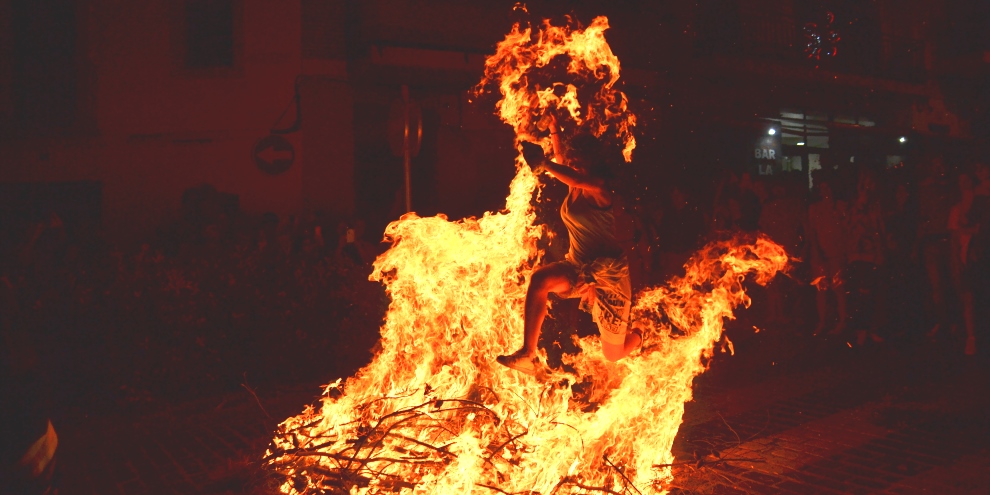
2012 was a special year for Jávea. Not only did the town celebrate 400 years of administrative independence from Denia but the fabulous ‘Nit dels Focs’ was afforded the distinction of ‘Fiesta de Interés Local de la Comunidad Valencia’ with the Valencian authorities acknowledging its draw for tourists and visitors from the surrounding region. It’s a wonderful, magical night of fires, a reminder of our ancestors spiritual obsession with the sun and their fear of the dark and the unknown.
There is little documentary evidence of the origins of the ‘Nit dels Focs’ in Jávea. Earliest records talk of a pilgrimage to the chapel of Sant Joan (which still survives, hidden up a long set of steps from the bus stop in Avenida d’Ondara behind Silvasol) where villagers offered grapes and figs to their revered saint and then jumped over fires, surely a strange eclectic mix of Christian and pre-Christian rituals. There is evidence that these fires were placed in several important positions, such as at the gates of the high wall that surrounded and, for the most part, protected the village until it was demolished in the latter half of the 19th century once the threat from raiders had diminished. Young people wore crowns of plants which were thought to have mystical powers and carried roasted beans given to them by the old folk of the village which were believed to prevent and cure infections and diseases.
When the cemetery was built next to the chapel of Sant Joan in the early 19th century, the celebrations moved to the Placeta del Convent and the offerings of fruit were made to the image of Sant Joan that had been placed in a niche in Carrer Teuleria (which is still in existence). Although there is little written evidence, it is known that the custom continued into the early 20th century as entertainment for children and young people but nothing like the sort of celebrations that soon developed.
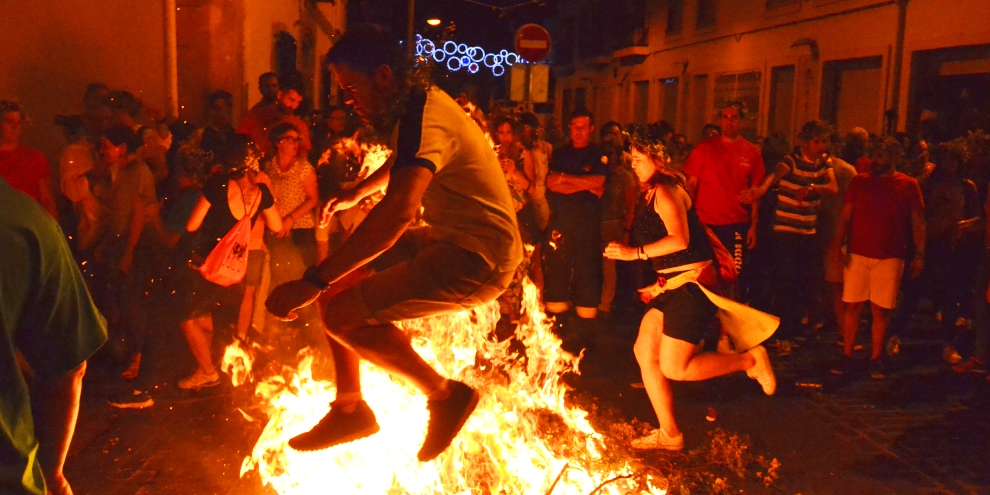
The current festivities of the Fogueres de Sant Joan have their roots in 1950 when a group of men sat chatting around a table in Bar Noi in the Placeta del Convent. They talked about popular fiestas in the Valencian region and decided that Jávea needed its own celebrations. And thus was born the Sant Joan fiesta. Yet it was not until the 1970s that the ‘Nit dels Focs’ became really popular and then in 1990 when Penya l’Escaldà began to organise this special night as part of the general Fogueres festivities. For more than two decades, the penya has been responsible for collecting the wood to make the fires and the plants, usually Clemmatis Flammula which is native to southern Europe, to make the crowns.
Yet the fire-jumping is only part of this special night. In 1987 the Quintà La Moguda decided to build a bonfire of old furniture in the Placeta del Convent around which they danced and sang songs. The following year, five penyas – ‘Desculats’, ‘Pensat i Fet’, ‘Rebolica’, ‘Moguda’ and ‘El Gerrot’ – all located in the Raval del Baix began to organise this special bonfire and since 1989 Penya El Gerrot has been responsible for collecting the old wooden furniture and junk to build the huge bonfire in Raval del Baix at the end of the fire-jumping.
The final act of the night is the correfocs which has been a valuable part of the ‘Nit del Focs’ since the 1990s. At first, the parade made its way through the narrow streets of the historic centre to finish in the church square but its popularity forced a change to the wider, longer streets of the perimeter roads which follow the old course of the old town wall.
The Fire-Jumping
Close to midnight, a large crowd begins to gather at Portal del Clot. As the night has become more popular, the number of people has increased and in recent years it has been estimated that more than 10,000 people participate. Most already have the floral crowns, picked up from large piles placed during the morning at the points where the fires will be placed. You’ll need to be quick. As the night has become more popular, so has the demand for the crowns and the piles quickly diminish. More greenery will appear in the evening but you’ll have to be ready to claim for enough to make your own crown.
Explosions in the night sky herald the arrival of Quintà and the members of the Fogueres Commission and representatives which has travelled along the Ronda Sur accompanied by the standard beat of drums and the pleasant sound of the ‘dolzaina’. Large baskets full of dried beans are carried by the entourage, their contents dished out to bring luck to those who would jump over (or through) the flames.
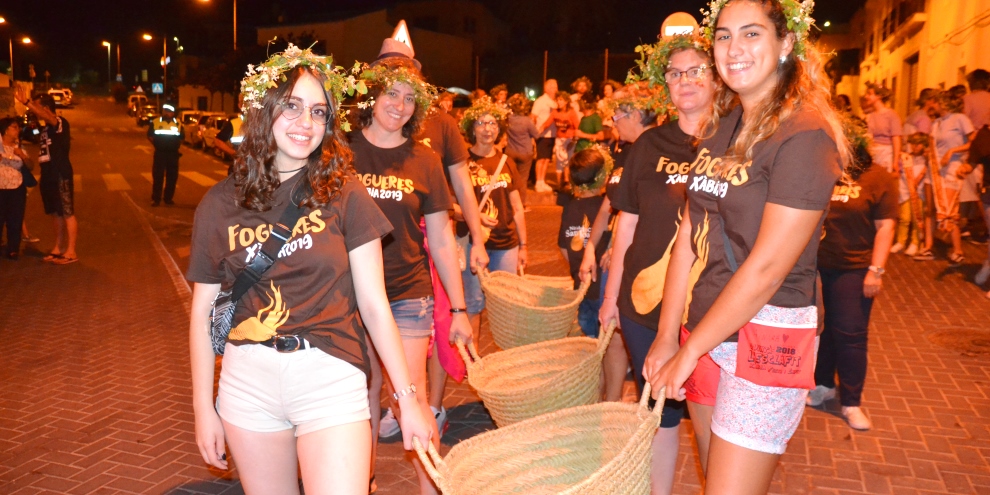
A huge crowd has gathered, people jostling to see as the first pile of wood and pine branches is placed on the road just by the stone cross. The pile is lit but just before the flames really take hold, it is tradition that the Fogueres Queen makes the first jump, usually accompanied by either the president of the Fogueres Comission or the town councillor responsible for Fiestas.
There’s a certain degree of good-natured (for the most part) pushing and shoving as people line themselves up to take a jump. The most brave jump first through the towering flames, often reaching two or three metres into the air. They rock gently on their feet and then, eyes and mouth closed, they leap as high and as fast as they can through the flames, accompanied by cheers from those waiting to jump themselves or from those content to watch from the sidelines. Most people hang about and wait until the flames die down a little bit and then make their jump. Sometimes the crowd is so big that you really don’t have any option but to wait, inching yourself along the road to get yourself into the right position to jump. There are normally many hundreds of people waiting to jump. It’s not a night for agoraphobics.
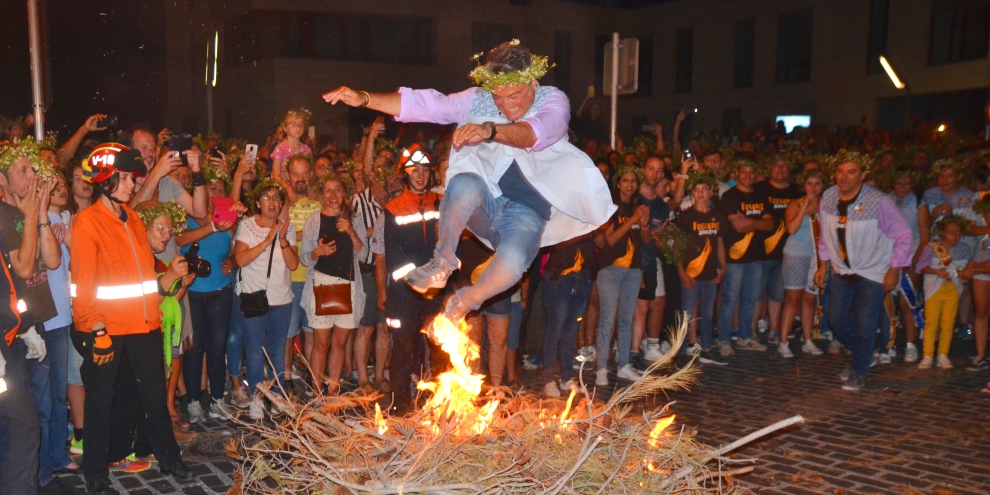
There are five more bonfires to cross. The next is at the stone cross next to Bar Trinquet which marks the site of the old Portal del Mar gatehouse; then we climb up to the Plaza de Marina Alta for the third fire before dropping down the Avenida Principe de Asturias to jump the fourth followed by the fifth on the edge of Placeta del Convent.
The last bonfire is at the junction between the Ronda Sur and Calle Virgen de la Merced; quite quickly this usually becomes a smouldering pile of greenery with the remnants of the crowns which some people have thrown into the fire for good luck. But hold on to yours and continue to follow the crowd as it makes its way through the dark narrow street of Calle de la Fuente to the Raval del Baix where the huge pile of old wooden furniture and junk is probably already well ablaze. Try and push your way through to the front and fling your floral crown into the inferno for good luck.
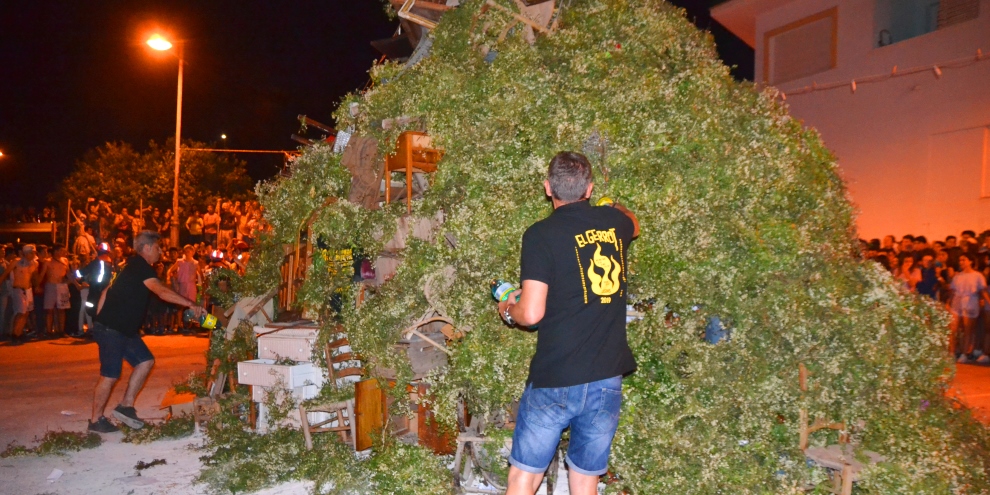
The atmosphere is electric as more and more people push their way into the small square. Music may already be playing over large speakers placed on the roofs of the surrounding buildings, pumping out the ‘Fogueres‘ song as the Quintà joins hands and begins to dance around the huge fire. Firemen spray down the surrounding buildings and open areas to reduce the risk of the fire spreading; put it out of your mind very quickly that there’s a petrol station just a few hundred metres away.
The powerful hoses provide brief showers of cooling water; it may be well past 1am but it’s hot around that raging inferno. The ground beneath your feet becomes a wide but shallow river so don’t wear your best shoes or those beach shoes that fall apart at the very hint of water.
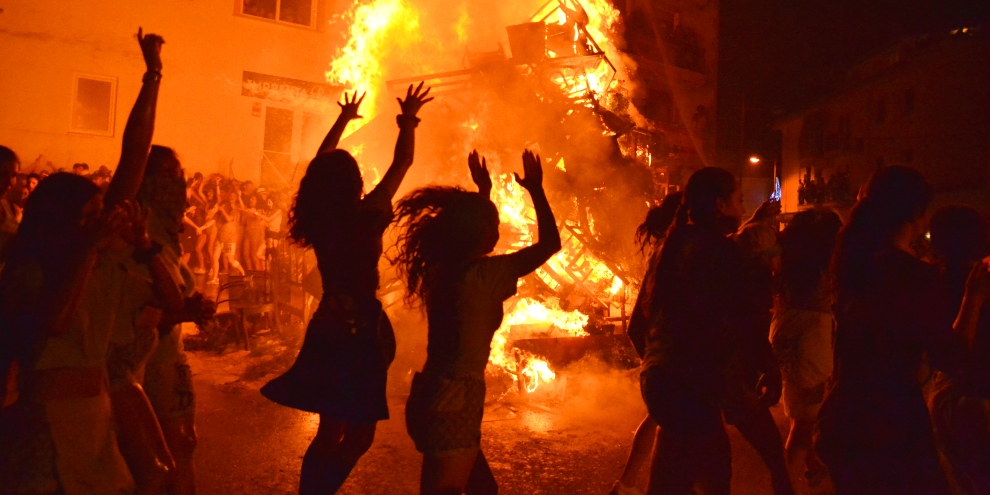
Allow the quintos to have their moment; it’s their fiesta so they should be allowed to join hands and run or dance around the huge inferno without others trying to join in. Once the flames start to die down, your chance will arrive as the quintos begin to drift off to get ready for the second-half of this very special night.
The Correfocs
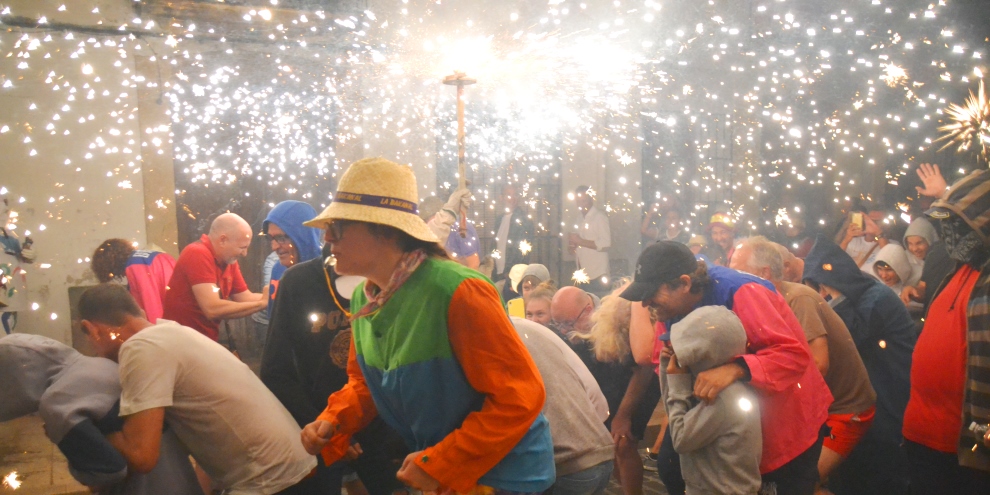
It’s well past midnight and the party’s still not over for a rhythmic pounding of drums begins as we prepare ourselves for the correfocs, literally “running with fires”.
Xarxa Teatro from Castellón are considered one of the best in the business and, after this experience, it’s not difficult to see why.
It all begins where the last bonfire has become a smouldering pile of embers. Suddenly, and without much warning, the drums start pounding, accompanied by the ‘dolzaina’ as a hooded figure, often a monk, pushes its way through the crowd, spraying the area in front of him with sparks from type of Roman candle. The atmosphere rises a notch as the drums change to a faster beat and sparks seem to explode from all corners of the square as the monk’s associates, dressed head-to-toe in white protective clothing, ignite their own arsenal.
The crowd can often be heard chanting “NO HI HA COETS!” over and over (it roughly means “there are no rockets”), taunting the purveyors of fire over their assumed impotence and encouraging them to reach into their protective boxes slung around their shoulders and prove them wrong. No-one escapes; if you are strolling along amongst the rest in the cavalcade, expect to be chased by bright white sparks. It hurts but only briefly; carry a bottle of water with you and if you feel a burning sensation, wash it quickly with the liquid to alleviate any pain. Don’t wear your best T-shirt – it will finish the day with small burn-marks – and it’s very much advisable to wear a hat of some sort and tie a damp handkerchief or bandana across the face as the smoke can be quite choking.
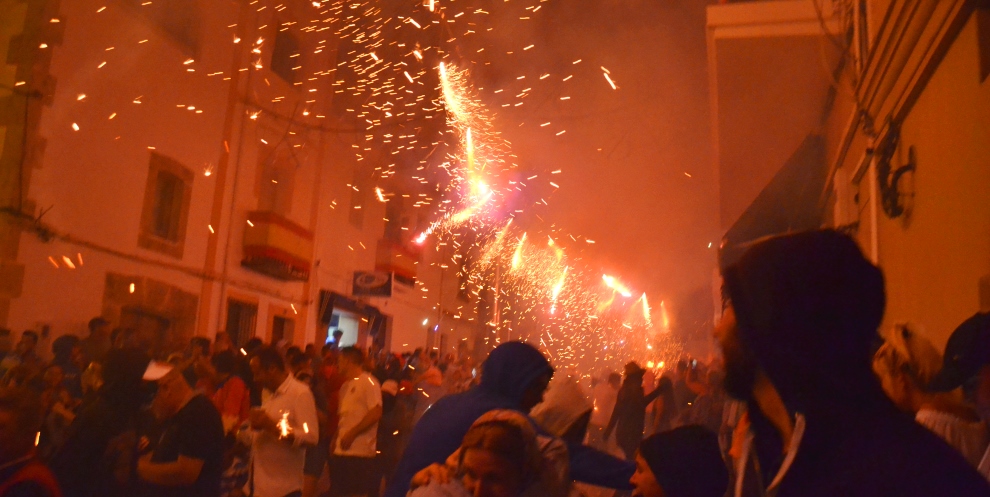
As the parade progresses around the outskirts of the historic centre along the same route as the fire-jumping earlier in the night, keep an eye on the balconies above for there are strings of firecrackers hung across the road at several locations. With a loud bang, the strings are set alive with cascades of burning sparks whilst the crowd jumps and chants below them. On occasions, huge frames are carried into the path of the crowd; they explode like giant Catherine Wheels as the people run through the shower of sparks to continue around the route. If these are not bad enough, watch out for the ‘toro de fuego’, a bull-resembling metal frame which has fireworks attached to it which are then set alight to provide a moving hazard; it’s probably developed from the controversial “toro embolado”.
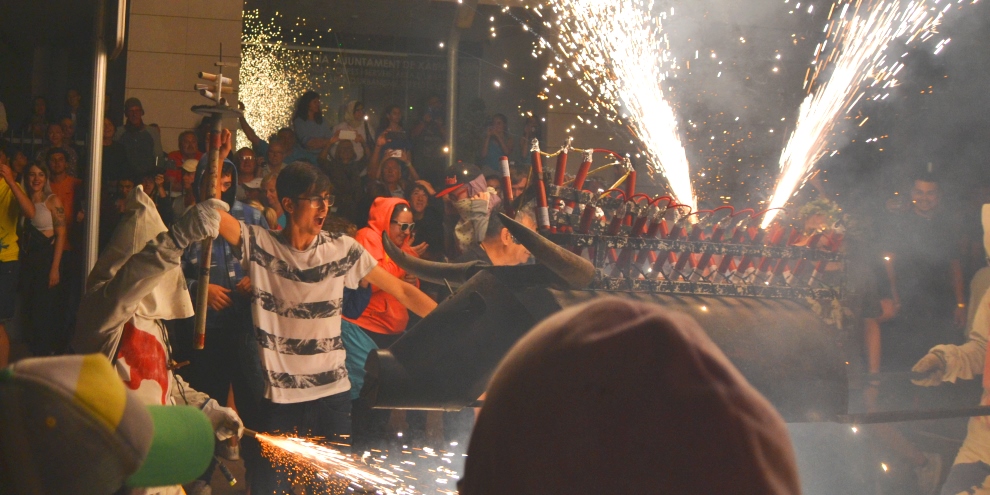
After about an hour or so, the procession makes its way into the Plaza de la Constitución where the fun continues for a few more minutes; watch out for the “bull” and maybe even a bicycle. As the square fills, the theatre company moves onto the large steps on one side and reveal themselves to cheers from the ground. The drums continue to pound the beat as everyone jumps up and down together, the floor beneath bouncing under the weight; who knows what it sounds like in the underground car-park below? The drums will stop; there is an air of anticipation as its not quite over yet. Suddenly, a little demon of fire flies through the air above them and ignites a huge framework of fireworks on the steps behind the theatre company as the drums start up again and everyone begins to jump up and down once more. This happens at least once more as the finale is delayed over and over again. And then it comes. It’s all over.
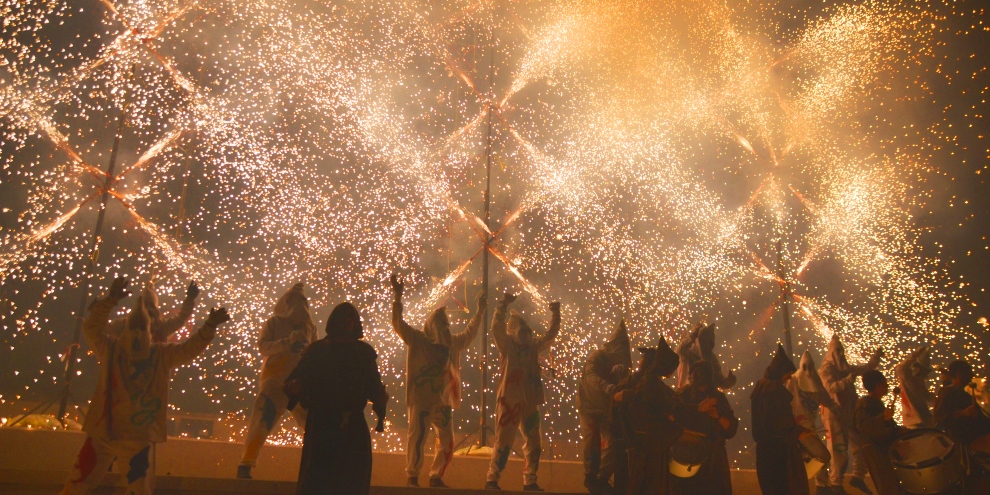
But not quite. If you have any energy left after a spectacular few hours, a live band bashes out its first number of the night from the stage to one side of the square. It’s 3am, probably later, yet there’s a chance to party until dawn and ensure that the ‘Nit dels Focs’ will be an event that will remain with you for a long, long time. It certainly will be a special night to remember.

